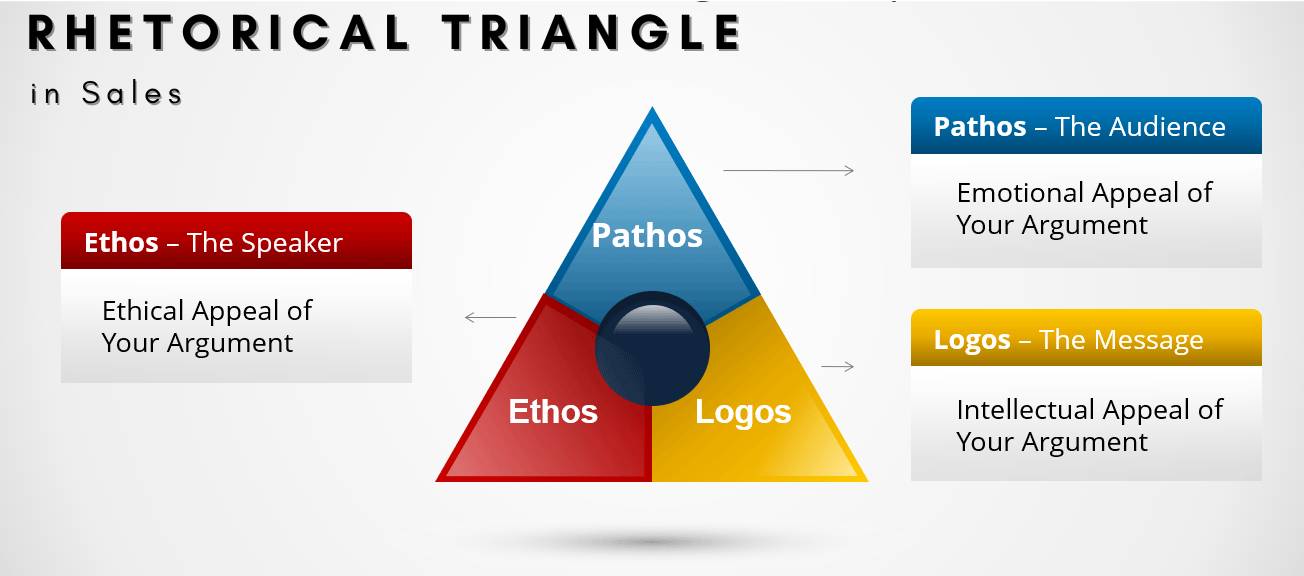Successful sales hinge on the ability to persuade. The Rhetorical Triangle, derived from Aristotle’s teachings, provides a robust framework for enhancing persuasive communication in sales. The three key components of this triangle—ethos, pathos, and logos—can significantly influence potential clients’ decisions.
Ethos establishes the sales professional’s credibility and trustworthiness. When a salesperson demonstrates expertise and reliability, they can effectively build rapport with a client.
Pathos, on the other hand, appeals to the audience’s emotions. Crafting a message that resonates emotionally can create a deeper connection and drive motivation to purchase.
Logos uses logical arguments and factual evidence to justify why a product or service meets the client’s needs. By integrating these three elements, sales professionals can create compelling narratives that attract attention and convert leads into sales.
For more insights, you can learn how to employ the techniques of the Rhetorical Triangle at StudioBinder.
Understanding the Rhetorical Triangle
The Greek philosopher Aristotle developed the rhetorical triangle as a framework for creating persuasive arguments. This method highlights the importance of balancing three key elements: ethos, pathos, and logos.
Defining the Rhetorical Triangle
The rhetorical triangle consists of ethos, pathos, and logos. Ethos refers to the speaker’s credibility or ethical appeal. It emphasizes the trustworthiness and authority of the individual presenting the argument.
Pathos involves appealing to the audience’s emotions. This element aims to create an emotional response, encouraging the audience to connect with the argument personally.
Logos represent logical appeal by using reasoning and evidence. This includes presenting facts, statistics, and logical arguments to persuade the audience through rational thought.
Balancing these three elements can strengthen persuasive communication, making arguments more compelling and effective.
The Role of Aristotle in Rhetoric
Aristotle played a significant role in shaping the concept of the rhetorical triangle. He identified ethos, pathos, and logos as central to persuasive communication. His work laid the foundation for understanding how these elements interact to create balanced arguments.
Aristotle proposed that effective persuasion requires integrating all three elements tailored to the audience and context. For example, in some cases, ethos might need more emphasis to establish credibility, while logos may be more critical for presenting evidence in others.
This model allows communicators to create well-rounded arguments that appeal to the audience’s ethics, emotions, and logic. This balance is crucial in various fields, including sales, politics, and everyday communication.
For additional insights on the rhetorical triangle, visit this resource. This provides a clear and structured approach to understanding these concepts.
Components of the Rhetorical Triangle
The rhetorical triangle consists of ethos, pathos, and logos. These three components are crucial when crafting persuasive arguments, particularly in sales. Each element uniquely appeals to the audience, builds credibility, and supports logical reasoning.
Ethos: Building Credibility
Ethos refers to the credibility and trustworthiness of the speaker or writer. Establishing an ethos is essential in sales. Salespeople must come across as knowledgeable and honest to gain the trust of their audience.
Credibility can be built through professional experience, certifications, and past performance. Sales representatives often rely on testimonials and case studies to enhance their ethos.
Moreover, a salesperson’s demeanor, language, and appearance can also impact the audience’s perception of their credibility.
Ensuring the information provided is accurate and reliable further strengthens ethos. Consistency in messaging and behavior reinforces trust, making the audience more receptive to the sales pitch. A solid ethos encourages the audience to positively engage with the sales message.
Pathos: Appealing to Emotion
Pathos involves appealing to the audience’s emotions. In sales, connecting emotionally with potential buyers can significantly influence their decision-making.
Emotional appeal can be achieved through storytelling, vivid imagery, and addressing the audience’s needs and desires.
Using stories that resonate with the audience can make the sales message more relatable and memorable.
Salespeople often highlight the benefits and outcomes of their product or service in a way that triggers a positive emotional response. This might include alleviating pain points or fulfilling a specific desire.
Visual elements and descriptive language are also powerful tools in invoking emotions. Engaging the audience emotionally helps create a deeper connection, making them more likely to respond favorably to the sales offer.
Logos: The Logic Behind the Argument
Logos refers to the logical appeal within the argument. In sales, logos is critical for providing a rational basis for why the product or service makes sense.
Effective use of logos involves presenting clear, logical reasoning supported by evidence and facts.
Salespeople can use data, statistics, and factual information to substantiate their claims. Demonstrations, case studies, and comparisons can help clarify the product’s or service’s benefits and functionality.
Organizing information logically and coherently ensures the message is easy to follow and understand. A strong logos approach gives the audience a solid foundation to believe in the product, making the sales argument more compelling and convincing.
Ethos in Sales
Ethos, an essential component of the rhetorical triangle, focuses on establishing the salesperson’s or brand’s credibility and trustworthiness. This section explains how building credibility and trust can enhance sales effectiveness.
Establishing Trust with the Audience
Building trust is crucial for successful sales. A salesperson must demonstrate credibility through both their knowledge and actions. Key steps include displaying expertise in the product or service and showing genuine interest in the customer’s needs.
Trust can also be established by being reliable. Meeting commitments promptly and maintaining consistent communication helps solidify a relationship.
For brands, trust is often built through a history of positive reviews and testimonials, showing a track record of satisfied customers.
Effective leadership within a sales team also contributes to ethos. Leaders set the standard for credibility by training their teams thoroughly and leading by example.
They ensure their salespeople are well-equipped to provide accurate information, which builds trust with the audience.
Pathos in Sales
Using pathos in sales involves leveraging emotions to create a deep connection with potential customers. This technique taps into feelings of fear, worry, and nostalgia to effectively influence purchasing decisions.
Emotional Triggers in Consumer Behavior
Emotional triggers play a crucial role in consumer behavior. Emotions such as fear and worry can drive urgency, prompting quicker decisions.
For instance, highlighting the potential risks of not using a product can make consumers feel uneasy, pushing them to purchase it as a precaution.
Advertising strategies often pull at the heartstrings. For example, showing imagery of family moments can create a sense of nostalgia, encouraging consumers to buy products that promise to recreate those feelings.
Understanding these triggers can help sales teams anticipate and address the emotional needs of their audience.
The Art of Persuasion Through Emotions
Effective use of pathos in sales is about creating a persuasive narrative that resonates emotionally.
Stories that evoke empathy and compassion can strengthen the connection between the brand and the customer. For example, brands can share testimonials of individuals whose product has improved their lives.
To manipulate emotions effectively, it’s essential to be genuine.
Customers can sense inauthenticity, which can backfire. Visual elements like images and videos, paired with emotive language, enhance this strategy.
Employing a balance of sentimentality and authenticity ensures the emotional appeal feels natural and convincing.
Logos in Sales
Logos in sales involves leveraging logic and reason to craft compelling arguments that persuade potential customers. By presenting clear, rational points supported by data, sales professionals can make strong, convincing cases.
Using Logic and Reason in Sales Arguments
Sales arguments grounded in logical reasoning help build trust and credibility. Logical arguments coherently connect the product’s features to the customer’s needs.
For instance, if selling a software solution, a salesperson could explain how its specific features address a client’s pain points.
Clear explanations that show the direct benefits and efficiency gains foster trust.
To be persuasive, the arguments must be straightforward and fact-based. Logical reasoning should eliminate ambiguities and highlight the direct advantages of the product or service.
This approach appeals to customers who prioritize rational decision-making.
Statistics and Facts as Persuasive Tools
Statistics and factual information enhance the credibility of sales pitches.
Presenting quantifiable data, such as success rates or cost savings, strengthens the logical argument.
For example, a sales pitch might include data showing a 40% improvement in productivity after adopting the proposed solution. Such figures provide tangible proof that can sway decisions.
Additionally, using industry benchmarks and case studies as factual support can underscore the effectiveness of the offering.
By relying on well-researched data, sales professionals can appeal to their audience’s logical thinking, making the case more compelling and harder to refute.
Creating Persuasive Sales Arguments
Crafting a persuasive sales argument is key to successful communication with potential clients. Effective rhetorical techniques can address objections and strengthen the appeal of the sales pitch.
The Structure of a Persuasive Argument
A persuasive argument in sales typically starts with establishing credibility (ethos). This involves the salesperson demonstrating their authority and trustworthiness.
Next, the argument should include logical appeals (logos), presenting clear facts and statistics.
Finally, incorporating emotional appeals (pathos) can connect with the audience personally.
A strong argument blends these elements seamlessly. Listing the product’s benefits, backed by data, and sharing success stories can be effective.
Ensure clarity in the presentation, avoiding jargon that could confuse the audience. Practicing active listening is important to tailor responses to the client’s needs.
Overcoming Objections with Rhetoric
Addressing objections requires skillful use of rhetoric.
Start by acknowledging the potential client’s concerns, showing empathy and building trust. Use ethos to reinforce your credibility and reassure them of your expertise. For instance, mention industry certifications or previous successes.
Logical reasoning is crucial here. Provide concrete evidence that counters the objection.
For example, if a customer doubts the product’s efficiency, share case studies or numerical data highlighting its effectiveness.
Emotional appeals can also help by sharing testimonials from satisfied customers, creating an emotional connection.
Overcoming objections is balancing appeals and finding the right mix to reassure and persuade the client. The goal is to shift objections into opportunities by addressing concerns directly and confidently.
The Power of Storytelling in Sales
Storytelling in sales enhances engagement by connecting with audiences emotionally and using narrative techniques to communicate effectively.
Connecting with Audiences on a Deeper Level
Storytelling captivates attention and makes messages more memorable. When sellers tell relatable stories, they create an emotional bond with the audience. This bond is formed through pathos, appealing to the emotions and fostering trust.
Stories also allow sellers to illustrate complex ideas simply, making it easier for the audience to grasp their message.
This use of narrative not only evokes emotion but also demonstrates an understanding of the audience’s challenges and aspirations.
Effective sales storytelling involves addressing the audience’s pain points and goals. By tailoring stories to the needs of each prospect, sellers can build a stronger connection based on empathy and relevance.
Narrative Techniques to Engage the Customer
Sales professionals employ different narrative techniques to engage customers.
One fundamental method is structuring the story with a clear beginning, middle, and end, which provides a logical flow. This approach caters to the logos aspect of the rhetorical triangle, appealing to the customer’s sense of reason.
Personalization is key in storytelling. Crafting stories that resonate specifically with the customer’s experiences and challenges demonstrates genuine understanding and consideration.
This boosts credibility by showcasing the seller’s expertise and relatability, touching on ethos.
An engaging story also includes vivid language and visuals that stimulate the imagination, making the narrative more compelling.
By incorporating descriptive language and concrete details, sellers can paint a vivid picture that captures the audience’s attention and fosters a deeper connection.

Rhetorical Strategies in Different Media
Different media require unique approaches to applying the rhetorical triangle.
Whether it is written content or visual media like videos, the techniques vary but aim to persuade the audience effectively through tailored language and strategies.
Adapting the Rhetorical Triangle for Written Content
Written content, such as articles and blog posts, effectively employ ethos, pathos, and logos to engage readers.
Ethos, or credibility, is established through well-researched information and authoritative writing.
Pathos, or emotional appeal, uses relatable stories and evocative language to create a connection with the audience.
Logos, or logical appeal, comes through presenting clear, reasoned arguments supported by data and facts.
Combining these elements strategically in content increases persuasion, making it more engaging and informative for the reader.
For more details on using these techniques, refer to this comprehensive guide.
Legal and Ethical Considerations in Sales
Legal and ethical considerations play a critical role in sales.
Ensuring compliance with laws and maintaining a high ethical standard safeguards a company’s credibility and trust.
Ethics in sales encompass principles guiding fair and respectful interactions with customers.
This includes avoiding manipulation and ensuring transparency during transactions.
Trust is built through honesty and consistency.
Sales teams must honor commitments and provide accurate information to establish long-term relationships.
Respecting a customer’s privacy policy is essential.
Proper handling of personal data and obtaining consent before using it are mandatory practices to prevent legal issues and build trust.
Authority in sales is linked with expertise and reliability.
Sales professionals should be knowledgeable and provide accurate, relevant information to maintain their authority and trust with clients.
| Legal Considerations | Ethical Considerations |
| Compliance with laws | Integrity and honesty |
| Data protection | Respect for privacy |
| Transparent contracts | Transparency in dealings |
By focusing on these concepts, companies can foster an ethical culture within their sales teams, ensure legal compliance, and build strong customer relationships.
This ultimately leads to sustainable success and a positive reputation in the market.
For further information, you can read more about fostering an ethical culture in sales and mastering sales ethics.



